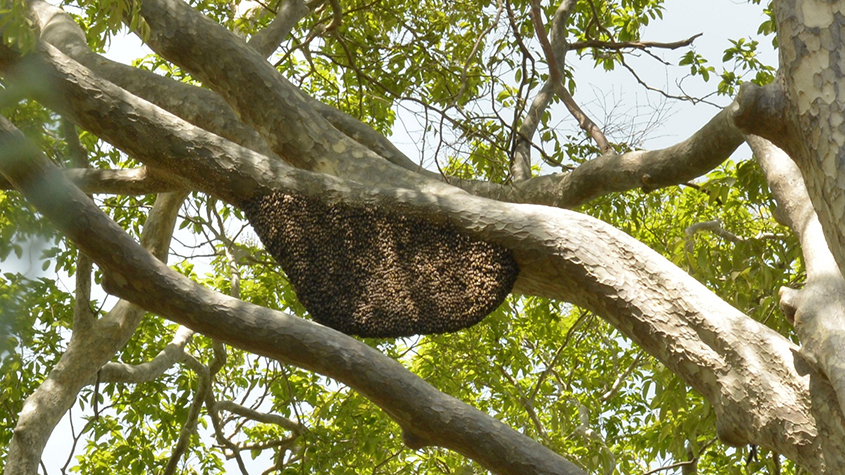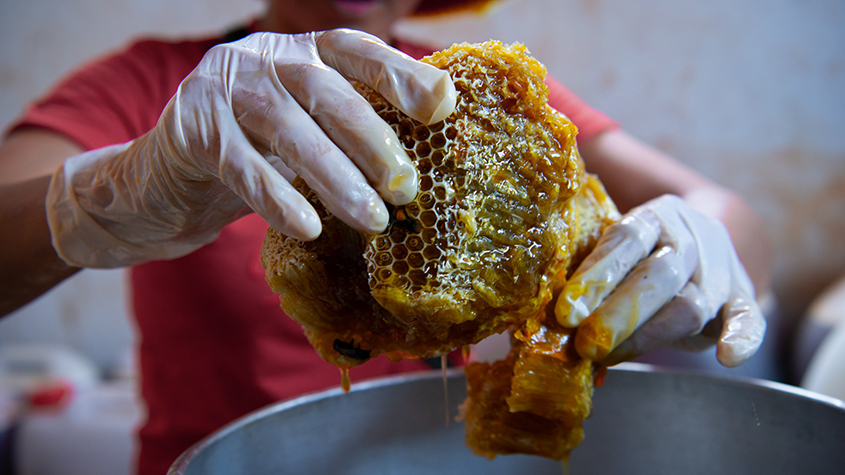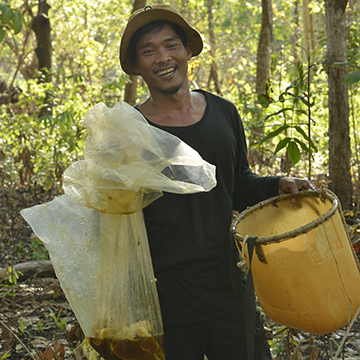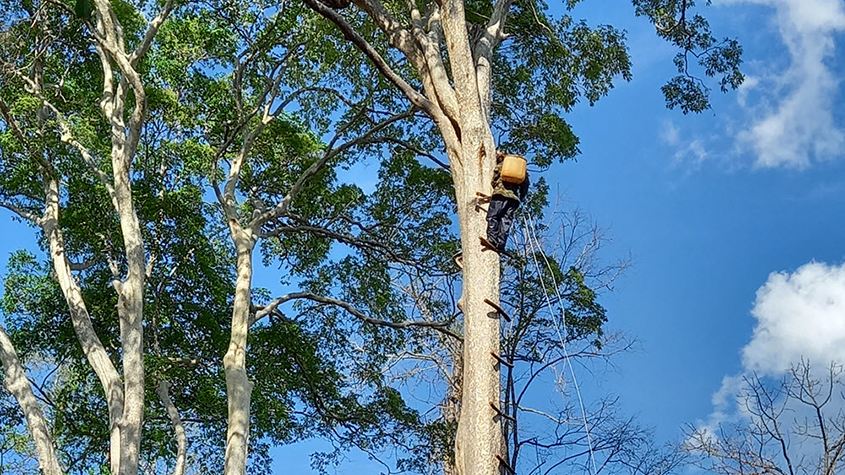eographical Indication Protects Giant Honey Bees and Expected to Raise Living Standards for the Pnong Indigenous Peoples
The Apis dorsata bee is a giant honeybee with little patience for interference and aggressive defense strategies but for centuries, in the northeastern thickly forested mountains areas of Cambodia, the Pnong ethnic group has mastered honey-harvesting skills. The wild honey from Mondulkiri, well known by Cambodian consumers, is now protected by a geographical indication, bringing hopes for increased revenue for harvesters, and heightened protection of wild bee colonies and the forest.

According to the story from time immemorial, the Pnong Peoples, ancestral forest trekkers and hunters, while running away from an angry swarm, discovered by chance that a wildfire held off the bees. Back at their cooking area, they found a bear eating some honeycomb and decided to try it too, realizing to their surprise that it was harmless and deliciously sweet. Since then, they have been harvesting the honey from the forest.
Specific Characteristics of the Mondulkiri Wild Honey
The “Mondulkiri wild honey”, which received a geographical indication (GI) certificate at the beginning of the year, has a unique type of sweetness and fragrance and a high viscosity, according to Rat Rotana, Program Manager at the Cambodian Institute for Research Rural Development (CIRD).
The honey comes in three distinctive colors with particular characteristics: red, a light golden shade, and dark brown, which has been kept in a jar for over a year and is believed to be of better quality for traditional medicine, according to Pnong peoples.

The characteristics of the “Mondulkiri wild honey” come from the agro-environmental conditions of the area, in particular the influence of the climate. The honey is collected only in the dry months of the year, from February to May, and the harvesting is based on the beekeeping experience of the Pnong Peoples and their deep knowledge of forests and bee sanctuaries.
Some 300 honey harvesters are active in the area, 73 of which, including 11 women have registered with the Mondulkiri Wild Bee Conservation Association (MWBCA) so far and follow the GI regulations. The CIRD and the WWF have been collaborating since 2019 to register the GI.
Benefits of being granted Protected Geographical Indication Status

The Pnong Peoples’ livelihood relies on small-scale farming of paddy rice, mung bean, cassava, cashew nuts, pepper, and the collection of non-timber forest products, such as mushroom, rattan, bamboo, traditional herbs, and honey. The wild honey from Mondulkiri had a solid reputation on the national market among consumers, and the potential to generate income for indigenous communities in the region. Prompted by requests from producers and market operators, the CIRD and the WWF supported the establishment of the inter-professional association (MWBCA) to prepare for the registration and management of the GI, Mr. Rat Rotana said.
Beyond the potential of increased living standards for indigenous people, improved honey quality and hygiene, and expected higher prices on the market, the GI also promotes conservation. Its charter includes the use of sustainable harvesting methods to protect and maintain the forest’s biodiversity. Members of the MWBCA now only collect 80 percent of the honey with a wooden knife, leaving the rest for the honeybees to continue their work. The honey can subsequently be collected two or three times per season. Harvesters do not kill the bees, which are kept away with smoke for the time of the harvest.

Some of the benefits generated by the sales of “Mondulkiri wild honey” have contributed to Community Protected Areas, sending patrols to the forest to prevent illegal logging and to protect brood and queen cells. Bees migrate to the hills from March to June and then go to the plains or costal mangroves during monsoons to seek food as well as to swarm.
Exporting Wild Mondulkiri Honey next on the cards
The Khmer Organic Cooperative (KoC), a social responsibility enterprise is working with CIRD and the MWBCA on the development of the packaging for the “Mondulkiri wild honey”, with plans to promote the GI and find export opportunities to countries in 2022, such as Japan and European Union members. KoC also works with Confirel, a company that has been promoting GI products in Cambodia since 2009, and focused on “Kampot Pepper” and “Kampong Speu Palm Sugar”. They are now interested in the “Mondulkiri wild honey” and plan to buy it for their European market, explained Mr. Rat Rotana.
“In the next two to three years, we hope that prices will rise slightly, but the important thing is to improve the quality and hygiene of the honey to meet the GI requirements and to prevent counterfeit products,” he said.
Confirel and KoC are buying the honey from the harvesters at a set price, which is discussed and approved by the MWBCA and its members. The honey is then dried, filtered, processed, bottled, and labeled by a company.
For the moment, the “Mondulkiri wild honey” has no organic certification, but the CIRD could provide technical support to the MWBCA and its members to work on such a certification, said Mr. Rat Rotana.
Medicinal Properties of Mondulkiri Wild Honey
The Pnong Peoples have used the wild honey for centuries and traditionally used it for daily food, mixed with potato, and as an energy drink (warm water, lemon, and honey). They also use one or two spoonful of honey to keep their body warm against cold weather, he said. “Mondulkiri wild honey” is also used in traditional medicine to treat ailments such as the flu, colds, and stomachaches. In the future, a research project on the “Mondulkiri wild honey” could allow the communities to promote the honey’s special medicinal properties.
The WIPO Division for Asia Pacific is currently helping the association to come up with a branding strategy based on a differentiated premium honey marketing approach using IP tools under the Branding Project.
Source: WIPO

 Client Focus
Client Focus